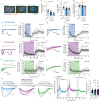Functional specificity of liquid-liquid phase separation at the synapse
- PMID: 39572583
- PMCID: PMC11582584
- DOI: 10.1038/s41467-024-54423-7
Functional specificity of liquid-liquid phase separation at the synapse
Abstract
The mechanisms that enable synapses to achieve temporally and spatially precise signaling at nano-scale while being fluid with the cytosol are poorly understood. Liquid-liquid phase separation (LLPS) is emerging as a key principle governing subcellular organization; however, the impact of synaptic LLPS on neurotransmission is unclear. Here, using rat primary hippocampal cultures, we show that robust disruption of neuronal LLPS with aliphatic alcohols severely dysregulates action potential-dependent neurotransmission, while spontaneous neurotransmission persists. Synaptic LLPS maintains synaptic vesicle pool clustering and recycling as well as the precise organization of active zone RIM1/2 and Munc13 nanoclusters, thus supporting fast evoked Ca2+-dependent release. These results indicate although LLPS is necessary within the nanodomain of the synapse, the disruption of this nano-organization largely spares spontaneous neurotransmission. Therefore, properties of in vitro micron sized liquid condensates translate to the nano-structure of the synapse in a functionally specific manner regulating action potential-evoked release.
© 2024. The Author(s).
Conflict of interest statement
Competing interests: The authors declare no competing interests.
Figures






Similar articles
-
VAMP4 Maintains a Ca2+-Sensitive Pool of Spontaneously Recycling Synaptic Vesicles.J Neurosci. 2020 Jul 8;40(28):5389-5401. doi: 10.1523/JNEUROSCI.2386-19.2020. Epub 2020 Jun 12. J Neurosci. 2020. PMID: 32532887 Free PMC article.
-
Fast vesicle recycling supports neurotransmission during sustained stimulation at hippocampal synapses.J Neurosci. 2002 Mar 1;22(5):1608-17. doi: 10.1523/JNEUROSCI.22-05-01608.2002. J Neurosci. 2002. PMID: 11880491 Free PMC article.
-
Disentangling the Roles of RIM and Munc13 in Synaptic Vesicle Localization and Neurotransmission.J Neurosci. 2020 Dec 2;40(49):9372-9385. doi: 10.1523/JNEUROSCI.1922-20.2020. Epub 2020 Nov 2. J Neurosci. 2020. PMID: 33139401 Free PMC article.
-
Condensate biology of synaptic vesicle clusters.Trends Neurosci. 2023 Apr;46(4):293-306. doi: 10.1016/j.tins.2023.01.001. Epub 2023 Jan 30. Trends Neurosci. 2023. PMID: 36725404 Review.
-
Synaptic Vesicle Clusters at Synapses: A Distinct Liquid Phase?Neuron. 2017 Mar 8;93(5):995-1002. doi: 10.1016/j.neuron.2017.02.013. Neuron. 2017. PMID: 28279363 Free PMC article. Review.
Cited by
-
RIM Mutants Occlude the Effects of Aliphatic Alcohols on C. elegans Locomotion.MicroPubl Biol. 2025 Jun 12;2025:10.17912/micropub.biology.001611. doi: 10.17912/micropub.biology.001611. eCollection 2025. MicroPubl Biol. 2025. PMID: 40611999 Free PMC article.
References
-
- Brangwynne, C. P. et al. Germline P granules are liquid droplets that localize by controlled dissolution/condensation. Science324, 1729–1732 (2009). - PubMed
-
- Chen, X., Wu, X., Wu, H. & Zhang, M. Phase separation at the synapse. Nat. Neurosci.23, 301–310 (2020). - PubMed
-
- Wu, X., Qiu, H. & Zhang, M. Interactions between membraneless condensates and membranous organelles at the presynapse: a phase separation view of synaptic vesicle cycle. J. Mol. Biol.435, 167629 (2023). - PubMed
-
- McDonald, N. A. & Shen, K. Finding functions of phase separation in the presynapse. Curr. Opin. Neurobiol.69, 178–184 (2021). - PubMed
Publication types
MeSH terms
Substances
Grants and funding
LinkOut - more resources
Full Text Sources
Miscellaneous

